>>> Bang for Your Buck
By staff writer David Nelson
July 9, 2006
Essential New Word of the Week: Skype (definition hint: See a doctor about that…)
Racial and cultural sensitivity is at an all-time low. The French think Americans are boors, and Americans think the French are smelly cowards. People of Arabic descent can’t go to airports without arousing suspicion, and God forbid they try to bring nail clippers onto the plane. Mexicans are unwanted, Canadians are ridiculed, and throughout it all, the Chinese continue to clone their invincible kung-fu soldiers.
The media is trying to fix this problem, with little success. They cast an Iraqi guy in Lost, but in real life, if I was marooned on some mysterious island with a former member of the National Guard, he’d be the first one I’d kill for food, and he better taste like falafel. And if you’re a wrestling fan, you’ve been brought up to believe that most foreigners are unscrupulous cheaters who demand you rise and pay respect as they sing their national anthems.
According to Gatorade commercials, the FIFA World Cup is also supposed to unite us. I don’t buy it. Soccer is popular and all, but how are countries supposed to start the healing process if they’re piss-drunk on warm beer, watching men in little shorts run up and down a field for approximately 4½ hours? If anything, soccer is going to do more harm than good. If there’s a sports-related riot in America, there might be about 8 or 9 injuries. When there’s a soccer riot in Europe, you’d be lucky to escape with that many teeth. That’s no way to foster good relations.
"Japanese cuisine is normally bland, so they respond with a snack that will actually damage human flesh. This may have something to do with WWII."
So, once again, it’s up to me to fix these problems. Now, I’m the first one to admit that I don’t know much about other cultures. I’ve seen Indiana Jones a few times, but all I learned is that foreign people are either Nazis, or they like to eat scooped out monkey heads. But that gave me a brilliant idea. I realized there is a way to understand different cultures: through snacking. The only thing that can unite us as world citizens is the pursuit of snack. For to comprehend a people's snack is to comprehend their way of life.
With this lofty goal in mind, I enlisted the help of a few friends, and one of them joined me as I set out to acquire as many foreign snacks as I could for under $20. My first destination was Chinatown, if I could find it. I’m not good with remembering where stuff is, and someday, the malt liquor industry will have to compensate me for that.
We entered a karate school to ask directions. Please don’t assume I’m racist because I thought a karate teacher would know how to find Chinatown. That’s just playing the odds. The sensei gave us some pretty cryptic instructions to follow. This was turning out like the Da Vinci Code, only for, you know, snacks. I knew we were getting closer. Finally, I suggested to my friend that we just follow the smell of pork that was wafting around. His reply: “Yup. Them Orientoids like their pork.”
You see, that’s the kind of overt bigotry I’m trying to mend with this experiment. But my idea worked, and we soon found ourselves in the middle of crowded, bustling Chinatown. Or as my friend called it, “Hong Kong Simulator.” We found a store that sold just about every terrifying snack you can imagine. According to its sign, the store was called [unintelligible squiggles] Asian Farm. I imagine the squiggles translated as “No Caucasians Allowed,” because we got some dirty looks as we stepped inside. I could have sworn I even heard some elderly lady grumble “damn round-eyes…”
My first multicultural lesson was that Chinese people don’t have a sense of smell, because that store had the worst “rotting-fish-meets-sweaty-Oriental-person” odor in history. It honestly could not have been worse if the smell somehow grew arms and started stabbing you. As for the snacks I bought, I had strict criteria. I wanted ones that barely qualified as edible, had little or no English in the ingredient list, and if possible, featured pictures of anthropomorphic food monsters on the packaging.
After loading up on Chinatown’s most enigmatic victuals, we headed for an ethnic area known to sell Indian, Latino, and Arabic food. Getting into the spirit of multiculturalism (and also tired as hell), I wanted to hire one of Chinatown’s many rickshaws, but my friend flat-out refused. I tried to convince him that certain Chinamen are bred for rickshaw pulling, injected with steroids, and turned loose to fulfill their destiny, but he still thought it would be humiliating.
So we walked, and it’s a good thing we did, because we happen to be Canada’s two whitest guys by a wide margin. And for Canada, that’s saying something. We were already getting a few suspicious stares in these ethnic neighborhoods. If we had arrived via rickshaw, like conquering Romans, all the multicultural understanding in the world couldn’t have prevented the ensuing beat-down and snack-mugging. We bought some more stuff, and beat a hasty retreat.
A week or so later, I assembled what can only be described as a Super All-Star Snack Squad. Of course, it was just some of my friends at a BBQ, but check out their snacking qualifications: I had a trained chef, a food scientist, a restaurant health inspector, and a food bank employee. And in case any of them went down in a horrible injury, I still had a science teacher, a doctor and a lawyer. Additionally, I invited the host’s two kids, because as far as snacking is concerned, I believe the children are our future. Teach them well, and let them lead the way.
Chinese Dried Potato
I wanted to ease my team into the experience with something non-threatening, so the first snack I pulled out was Chinese dried potato. This product consisted of gigantic orange lumps of visually unidentifiable material. Naturally, I had them guess what it was before tasting. The closest anybody came was “dried mango,” worth partial credit. Expecting the sweet taste of mango, they each took a lump of the dried potato, and my experiment was nearly over before it began.
These things tasted horrible. One tester described them as bark, if bark were chewy and orange. Clearly, insane metaphors were one of this product’s side effects. I was confused. How could something as simple as dried potato be so offensive? Then, it occurred to me that just because the packaging says dried potato, doesn’t mean it’s the truth. I’m not even Irish, but I can tell you that what we ate were not potatoes. I saw two possibilities. Either we ate some kind of crazy Chinese yam with no English translation, or else it was a rodent that had been subjected to the desiccation process and deliberately mislabeled. I made a note to have the crime lab investigate this at a later time.
Multicultural lesson learned: Potato misrepresentation is a serious offence in my book. Even after all these years, the Chinese are still inscrutable.
Cuttlefish Flavored Snack
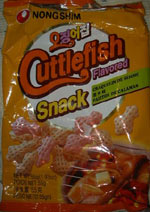 The next item I brought out was called “Cuttlefish Flavored Snack,” a product of Korea. Right away, the Koreans earned extra points from me by actually including the word “Snack” in the product name. That’s super-helpful. The label even pointed out that the Nong Shim company was a member of the Snack Food Association, an organization it is my destiny to someday lead. I really thought these things were going to bomb in the taste test; they looked like misshapen bits of cereal in hues of pink and brown. Also, I don’t entirely know what a cuttlefish is, but it sounds kind of disgusting and threatening, like it might attack a submarine. A quick visit to Wikipedia confirms this theory and inspires nightmares for a week.
The next item I brought out was called “Cuttlefish Flavored Snack,” a product of Korea. Right away, the Koreans earned extra points from me by actually including the word “Snack” in the product name. That’s super-helpful. The label even pointed out that the Nong Shim company was a member of the Snack Food Association, an organization it is my destiny to someday lead. I really thought these things were going to bomb in the taste test; they looked like misshapen bits of cereal in hues of pink and brown. Also, I don’t entirely know what a cuttlefish is, but it sounds kind of disgusting and threatening, like it might attack a submarine. A quick visit to Wikipedia confirms this theory and inspires nightmares for a week.
Surprisingly, my Snack Squad seemed to really enjoy the Cuttlefish snack. Comments included a comparison to those shrimp chips that grab your tongue, which aren’t so bad. Another friend said it tasted like delicious fishy styrofoam, or what he dubbed “styrofish.” After trying them myself, I was forced to agree.
Multicultural lesson learned: Don’t prejudge Koreans; they’ll surprise you every time. Their snacks look horrible, but they taste delicious. Likewise, I’ve heard that Korean women might look plain, but they’re incredible in the sack. Just try not to think about cuttlefish when you’re with one.
BBQ Fried Dough
My third snack was one I had been looking forward to: BBQ Fried Dough. According to the only English on the label, these golden brown nuggets were made by the Happy Cereals and Oil Company, located in the Hi-Tech Industrial Centre of Hong Kong. And truly, that information should have been some sort of a warning, but the prospect of snacking on fried dough blinded me to all logic and reason.
One of my friends said these things tasted like Chinatown and looked like the dried pigs that hang in the windows there. Another compared them to the “lardy, elbowy bits in the joint of a chicken wing.” I thought they tasted good! But my snackers pressed on with the criticism, calling them “5-year-old cornflakes,” and “Cartilage vittles.” I still had tons of them left, and I wanted them to finish the bag, but they flat-out refused. One of the kids started crying and was promised he didn’t have to eat any more. Someone even suggested using the Cuttlefish snack as a palate cleanser before moving on to the next item.
Multicultural lesson learned: Hong Kong was probably better off in the hands of the British, at least as far as snacking is concerned.
Dried Chenpi
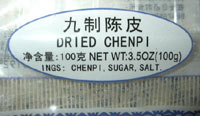
Out came a product called Dried Chenpi. In case you don’t know what Chenpi is, the Chinese manufacturers provided the ingredient list to help you out. Thanks to the magic of Google, I knew what my friends were about to eat, even if they didn’t. And it’s a good thing too, because these tangy, soapy morsels were said to suck all moisture from my tasters’ mouths. Even though they were aromatic, they still looked like flaked goat dandruff and tasted like sour detergent.
Multicultural lesson learned: Chenpi is apparently Chinese for orange peel. But don’t let that fool you. Chenpi is still gross, and it gives you SARS, probably.
Super Mango Paleta Lollipop
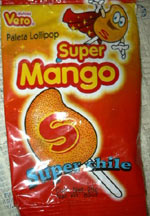
My next item was more identifiable, but at least it had an excitable food creature as its mascot. Super Mango Paleta Lollipop with Super Chile comes from Mexico and features a cape-wearing mango treat on the wrapper. Either this is meant to appeal to kids, or else the manufacturers have been hitting the peyote a little too often. Reviews of this product were universally bad. One taster said the lollipop resembled a sandy dog turd on a stick. The sand in question is actually chili powder, which I suspect may have been put there by candy-hating extremists.
I’m not an expert in Mexican candy. In fact, all I know is to get a good jump when it comes out of a piñata, and throw lots of elbows to ensure maximum pick-up. But I have to think it’s questionable to combine mango candy with guajillo chili powder. I mean, what are the manufacturers trying to do to poor little Mexican children? Is it not bad enough that Kathie Lee Gifford makes them sew track pants for 39 cents an hour? They should have access to candy that doesn’t hurt if you rub your eyes after eating it.
Multicultural lesson learned: When it comes to the Mexicans, you have to take the good with bad. Sure, a never-ending stream of immigrants might put a strain on the economy, but on the other hand, guacamole is delicious!
Halwani Brothers Maamoul/Sweet Tamarind Balls
I had two items from Saudi Arabia, which we sampled more or less simultaneously, because we were all getting kind of queasy and the kids were becoming visibly upset by the lack of anything even remotely edible. Halwani Brothers Maamoul is a kind of walnut/date cookie, not unlike a Fig Newton. While one holdout declared his approval by giving a thumbs-up in the general direction of Mecca, the rest of us agreed we’d rather eat Chenpi than Maamoul anytime soon.
As for the Sweet Tamarind Balls, there’s not much to be said. One of my tasters said that her body was rejecting them outright. Personally, I think she just had an aversion to balls in her mouth. Among the few who could actually stomach them, these treats were described as sour raisins on steroids.
Multicultural lesson learned: Someday, science will invent a car that runs on solar power, or delicious maple syrup. When that day comes, I hope the Arabs aren’t counting on their snack export industry to make up for losses in crude oil.
Collon
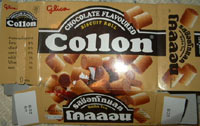
I felt the Snack Squad had earned a reward for not violently expelling the cuttlefish-mango-potato-orange peel mixture that was now settling in their stomachs. So, I gave them a delicious chocolate snack, albeit one with a hilarious name. I had seen the same product in Japan, but this one was clearly from Thailand. Knowing that, I suppose I should be grateful that I didn’t find anything unusual in my Collon.
I’m not sure if it’s deliberate, but these little biscuits look just like a cross-section of a small intestine. But they tasted great, like chocolate mousse wrapped inside a wafer. With their will to live temporarily restored, the snackers polished off an entire bag, trying to avoid mentioning the product by name.
Multicultural lesson learned: Even if they’re not great at naming things, like their snacks or their capital city of Bangkok, the Thais are agreeable, pleasant, and friendly. And if you visit the right parts of Bangkok, you’ll find the locals will bend over backwards to please you.
[Deluxe Robot Panties Habanero]
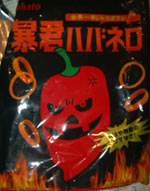
The final stop on my snacking tour was Japan, and I brought out a product to really punish my team for daring to want to help me. Given my limited knowledge of Japanese, I could decipher that it was called Deluxe Robot Panties Habanero. Actually, “habanero” is the only word I’m sure of. But who cares, because holy shit! Look at the size of that food monster on the package! Is that some kind of mutated pepper, or Spongebob’s satanic half-brother? I knew Japan wouldn’t let me down.
They came in the form of oversize rings, all the better to wear on your cock and let the habanero monster work his magic. This snack received poor reviews, meaning it won’t qualify as a secret ingredient on Iron Chef. I sampled a handful anyway, and the water streaming out of my eyes told me something: Either my work in cultural diplomacy had moved me to tears, or else these things were hot enough to burn a Caucasian’s face off.
Multicultural lesson learned: Japanese cuisine is normally bland, so they respond with a snack that will actually damage human flesh. This demonstrates the Japanese need to overcompensate for their shortcomings. This may have something to do with WWII and/or their tiny, tiny penises.
Conclusions:
This experiment has led me to believe that global multicultural harmony isn’t just a pipe dream. But the role of snacks in this newfound peace must not be underestimated. Some time ago, Danish newspapers published controversial cartoons depicting the prophet Mohammed as a terrorist. As a result, outraged Muslims stopped calling Danish pastries “danishes,” opting instead for “Roses of the Prophet Mohammed.” The snack world is still reeling.
It’s hard to say if this is more or less retarded than the lobbyist who wanted to change French fries to “Freedom Fries,” but I do know this: People may disagree on any number of political issues, but let’s not take it out on our snacks. Snacks should be instruments of understanding and diplomacy, not wacky revenge. I don’t want to wake up in a world where Cheese Nips are banned because Orientals find them offensive. I’d rather we just give some to the North Koreans in exchange for their favorite Taepodongs.
Essential New Word of the Week:
Skype [‘skajp] n: Also known as “The Skype”; a disease of indeterminate origins, symptoms, and cures. Basically, a health problem you don’t yet know anything about.
I was at a party last week where a guy decided to make a really lengthy long-distance call. He told us that Skype was footing the bill for it. Not knowing what Skype is, I immediately assumed it was some sort of magical fish. But another friend insisted that it was a disease he once caught. He was surely correct. All night long we traded symptoms and homemade remedies for the Skype. So if your partner ever asks you about that rash that won’t go away, or the mole that’s getting bigger, you can tell him/her “I caught the Skype.”
